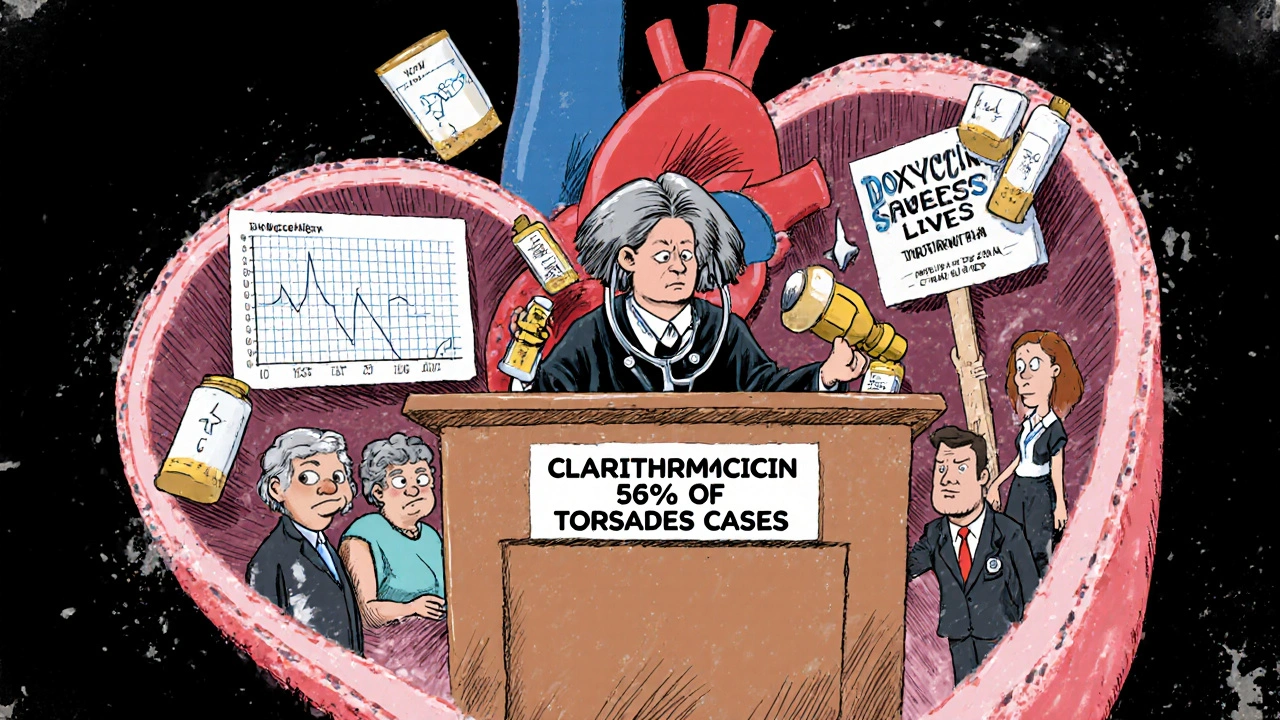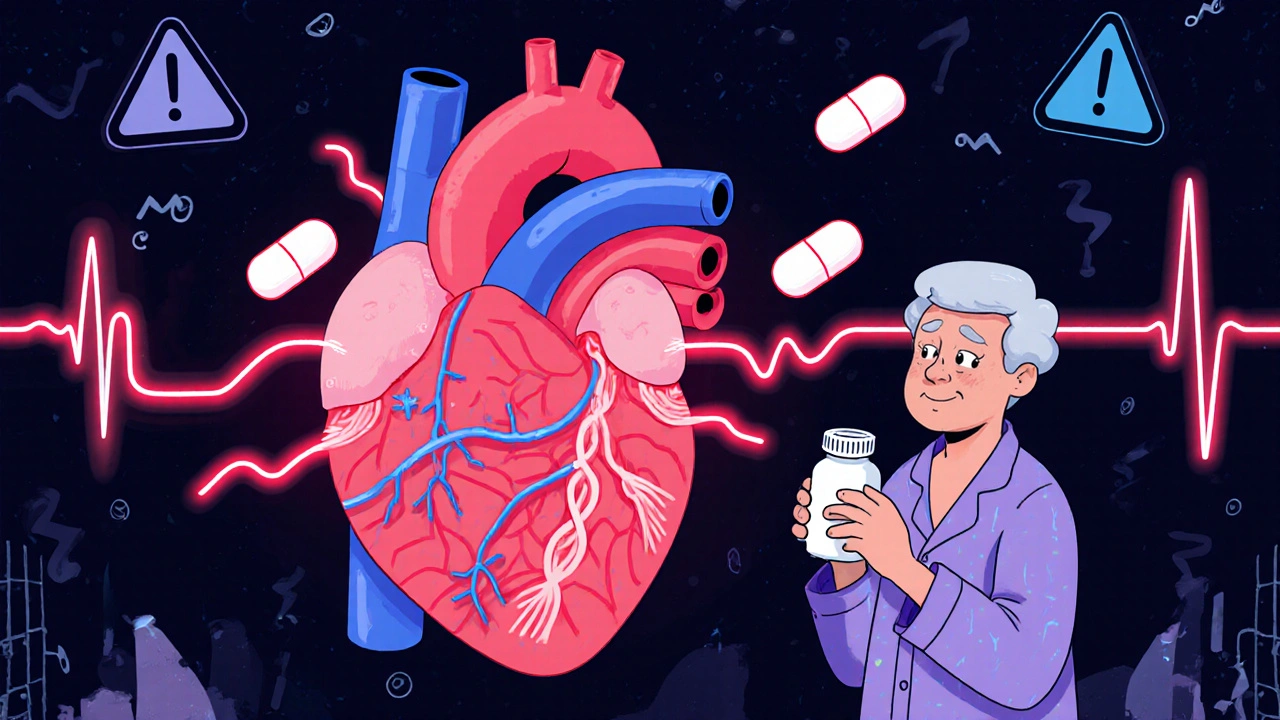QT Prolongation Risk Calculator
Assess Your Risk
Calculate your risk of QT prolongation when taking macrolide antibiotics like azithromycin or clarithromycin.
When you take an antibiotic like azithromycin or clarithromycin for a stubborn sinus infection or bronchitis, you’re probably not thinking about your heart. But for some people, these common drugs can quietly disrupt the heart’s electrical rhythm - sometimes with deadly results. The risk isn’t high for most, but it’s real, and it grows fast when other factors line up. This isn’t theory. It’s documented in hospital records, FDA reports, and decades of clinical studies. And if you’re over 65, on multiple meds, or have even a mild heart condition, you need to know what you’re really signing up for.
How Macrolides Disrupt the Heart’s Timing
Macrolide antibiotics - azithromycin, clarithromycin, and erythromycin - work by stopping bacteria from making proteins. But they also sneak into heart cells and block a tiny potassium channel called IKr. This channel is part of the system that resets the heart after each beat. When it’s blocked, the heart takes longer to recharge between beats. On an ECG, that shows up as a longer QT interval. That’s not just a number on a screen. A prolonged QT interval can trigger a dangerous rhythm called Torsades de Pointes, a twisting, chaotic heartbeat that can lead to sudden cardiac arrest.
The mechanism is well understood. Research from 2023 shows clarithromycin and roxithromycin block IKr more strongly than azithromycin, which explains why clarithromycin carries the highest risk. Even azithromycin, once thought to be safer, can prolong the QT interval by 5 to 10 milliseconds at standard doses. That might sound small, but in a vulnerable heart, it’s enough to tip the balance.
The Real Numbers Behind the Risk
For a healthy 30-year-old with no other meds and normal electrolytes, the chance of developing Torsades from a five-day course of azithromycin is less than 1 in 100,000. That’s rare. But risk doesn’t stay low when other factors appear.
Studies show that if you already have a prolonged QT interval - say, over 450 ms in men or 470 ms in women - your risk jumps more than 24 times. If you’re also taking another QT-prolonging drug, like a common antidepressant or a diuretic that lowers potassium, your risk multiplies again. A 2022 JAMA Internal Medicine study found that 42% of macrolide prescriptions in cardiac patients were given alongside another drug known to prolong QT. That’s not accidental. It’s a pattern.
Clarithromycin is the biggest offender. Despite making up only 15% of macrolide prescriptions, it accounted for 58% of the 287 Torsades cases reported to the FDA between 2010 and 2020. Azithromycin, while less potent, still caused 37% of those cases. And the people hit hardest? Elderly patients with heart failure, kidney disease, low potassium, or a history of arrhythmias.
Who’s Most at Risk? The 7 Key Factors
It’s not just about the drug. It’s about the person. The American Heart Association identifies seven major risk factors that turn a low-risk drug into a high-risk one:
- Female sex - women are 2 to 3.5 times more likely to develop Torsades
- Age over 65 - risk increases 1.8 times
- Structural heart disease - heart failure, prior heart attack - doubles the risk
- Electrolyte imbalances - low potassium or magnesium raises risk 3 times
- Concurrent QT-prolonging drugs - this is the biggest multiplier - risk jumps 2.5 to 5 times
- Renal impairment - kidneys clear these drugs; if they’re weak, levels build up - 1.7 times higher risk
- Genetic predisposition - undiagnosed long QT syndrome - risk increases 5 to 10 times
Many of these are silent. Someone might not know they have mild heart failure. Or they might be taking a diuretic for high blood pressure and not realize it’s draining their potassium. Or they’ve never been tested for long QT syndrome because they’ve never had symptoms.
The Azithromycin Debate: Is It Safe?
One of the most confusing parts of this topic is the back-and-forth on azithromycin. In 2012, a landmark study by Dr. Wayne Ray in the New England Journal of Medicine found azithromycin linked to a 2.88 times higher risk of cardiovascular death compared to amoxicillin. That sent shockwaves through the medical community. The FDA issued a warning. Prescriptions dropped.
But then came the counter-studies. In 2018, a reanalysis of the same data - this time adjusting for 108 variables like smoking, diabetes, and recent hospital visits - found the risk vanished. The odds ratio was 1.01. No increase. The original spike, researchers argued, wasn’t caused by the drug. It was caused by the reason people were prescribed it: severe infections, often in people already near death.
That’s called confounding by indication. It’s a classic trap in observational studies. Just because two things happen together doesn’t mean one causes the other. But here’s the catch: even if the overall population risk is low, the risk for specific subgroups - the elderly, the sick, the polypharmacy patients - remains real. And that’s what matters in the clinic.
What Doctors Are Doing About It
There’s no universal rule. Some cardiologists insist on an ECG before prescribing any macrolide to patients over 65. Others only check if the patient has three or more risk factors. A 2023 survey of physicians on the American College of Physicians forum showed 62% routinely check potassium levels before prescribing, while 38% only act if symptoms appear.
But systems are changing. Kaiser Permanente, which serves over 12 million people, added automated alerts to its electronic health record in 2017. If a doctor tries to prescribe clarithromycin to a patient with a QTc over 470 ms or on another QT-prolonging drug, the system pops up a warning. The result? A 28% drop in high-risk prescriptions.
Tools like the University of Arizona’s QT Risk Score - a 10-point calculator - are being adopted in more clinics. A score of 7 or higher means avoid macrolides entirely. A score of 4 to 6 means check electrolytes and avoid other QT drugs. Below 4? Generally safe.

Alternatives That Won’t Shake Your Heart
You don’t need a macrolide for every infection. For community-acquired pneumonia, doxycycline is just as effective and carries virtually no QT risk. For sinusitis, amoxicillin remains first-line. Even respiratory fluoroquinolones like levofloxacin - often used as alternatives - come with their own QT risks, so they’re not always safer.
The real alternative is better diagnosis. Many respiratory infections are viral. Antibiotics don’t help. Overprescribing is part of the problem. If you’re not sure it’s bacterial, wait. Watch. Test. Sometimes, the safest antibiotic is none at all.
What You Can Do
If you’re prescribed a macrolide:
- Ask: “Is this the safest choice for me, given my other meds and health conditions?”
- Know your medications. Make a list of everything you take - including OTC drugs and supplements. Bring it to every appointment.
- Ask if your potassium or magnesium levels have been checked recently.
- If you feel dizzy, faint, or notice your heart racing or skipping, stop the drug and get help immediately.
- Don’t assume “it’s just an antibiotic” means it’s harmless. The heart doesn’t know the difference between a drug meant to treat and one meant to harm. It only responds to the electrical signal.
The goal isn’t to scare you away from antibiotics. It’s to make sure you’re not taking one that could harm you - especially when safer options exist.
What’s Next for These Drugs?
Solithromycin, a newer macrolide-like drug, showed no QT prolongation in trials. But the FDA rejected it in 2016 because of liver toxicity. That’s the trade-off: fix one risk, create another.
Meanwhile, use of clarithromycin in cardiac patients has dropped 34% since 2013. Azithromycin use hasn’t budged - still the 13th most prescribed drug in the U.S. But awareness is growing. The American College of Cardiology’s 2024 expert statement will likely push for stricter screening before prescribing.
By 2027, experts predict a 15-20% further decline in clarithromycin use for patients with heart conditions. The message is clear: macrolides aren’t going away. But their place in high-risk patients is shrinking - and that’s a good thing.
Can azithromycin really cause a dangerous heart rhythm?
Yes, but only under specific conditions. Azithromycin can prolong the QT interval and trigger Torsades de Pointes, especially in people with existing heart conditions, low potassium, or who are taking other QT-prolonging drugs. For healthy young adults with no other risk factors, the risk is extremely low - less than 1 in 100,000. But for someone over 65 with heart failure and on a diuretic, the risk increases dramatically.
Is clarithromycin more dangerous than azithromycin?
Yes. Clarithromycin blocks the heart’s potassium channel more strongly than azithromycin, leading to greater QT prolongation. Studies show it causes over half of all reported Torsades cases linked to macrolides, even though it’s prescribed less often. It’s also more likely to interact with other drugs because it inhibits liver enzymes that break down many medications. For patients with any cardiac risk, azithromycin is usually preferred - but only if no better alternative exists.
Should I get an ECG before taking a macrolide antibiotic?
If you’re over 65, have heart disease, take other medications that affect heart rhythm, or have a history of fainting or irregular heartbeat, yes. An ECG checks your baseline QT interval. If it’s already prolonged, you shouldn’t take a macrolide. Even if you’re younger, if you’re on multiple drugs or have kidney problems, ask your doctor. Many clinics now use automated risk tools that flag these cases before the prescription is even written.
What if I’m already on a QT-prolonging drug? Can I still take a macrolide?
It’s risky. Combining macrolides with other QT-prolonging drugs - like certain antidepressants, antifungals, or heart rhythm meds - can multiply the danger. If you’re on one of these drugs, your doctor should avoid macrolides entirely. Alternatives like doxycycline or amoxicillin are safer. If no alternative exists, your doctor may check your electrolytes, reduce the dose, and monitor you closely with repeat ECGs. Never combine these drugs without medical supervision.
Are there antibiotics that don’t affect the heart’s rhythm?
Yes. Doxycycline, amoxicillin, and cephalexin have minimal to no effect on the QT interval. For most common infections - sinusitis, strep throat, urinary tract infections - these are just as effective as macrolides. Even for pneumonia, doxycycline is often preferred over azithromycin in older adults because it avoids cardiac risks entirely. Always ask: is there a safer option?
What symptoms should I watch for after taking a macrolide?
If you feel sudden dizziness, lightheadedness, fainting, or notice your heart racing, fluttering, or skipping beats, stop the medication and seek help immediately. These could be signs of a dangerous arrhythmia. Don’t wait. Even if you feel fine afterward, get an ECG. Early detection saves lives. These symptoms are rare, but when they happen, they happen fast.
